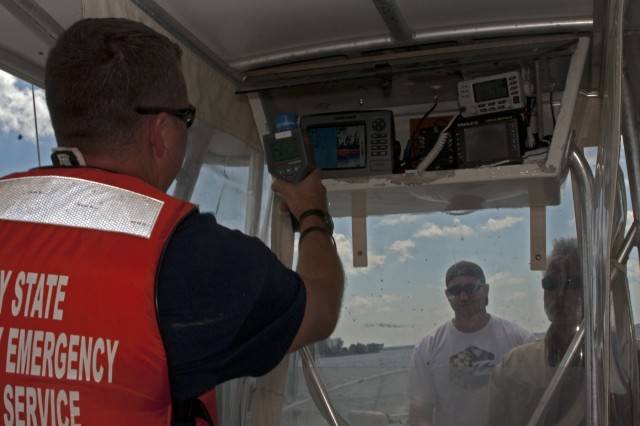 |
| New York Army National Guard Staff Sgt. David Hansen, a survey chief from the New York National Guard's 2nd Civil Support Team uses an Identifinder to check for radioactive materials aboard a suspect boat during Operation Clear Passage, a three-day, multi-agency homeland security exercise and water quality/navigational-boating enforcement event held on Lake Champlain from July 22 to 24. (Photo Credit: Master Sgt. Raymond Drumsta) |
By Master Sgt. Raymond Drumsta,
New York Army National Guard
July 29, 2016
ROUSES POINT, N.Y. -- With a lift from a New York Naval Militia patrol boat, the New York National Guard's 2nd Civil Support Team demonstrated their skills detecting radioactivity during Operation Clear Passage.
Working from the 28-foot boat, the team of New York Soldiers and Airmen boarded vessels stopped by law enforcement to search for radioactive material that could be used to make a dirty bomb during the homeland security exercise held in and around Lake Champlain from July 22 to 24.
The National Guard team and New York Naval Militia were among the more than 75 personnel from 17 federal, state and international agencies who conducted law enforcement, homeland security and environmental monitoring missions throughout the exercise.
With their knowledge and expertise, the 2nd Civil Support Team played an integral role in the exercise, according to New York Army National Guard Maj. Amy Benedetto, the deputy team commander.
"All we do is train to respond to (chemical, biological, and radiological) incidents," Benedetto said. "Law enforcement has this as an additional duty. We're the subject-matter experts for them. They rely on us for knowledge."
During the exercise, the 2nd Civil Support Team was tasked with finding radioactive material on a boat, on Valcour Island, and in a parking lot, said Sgt. 1st Class Brandon Willit of the New York Army National Guard. Trainers used a small radiation source to test team members.
After rallying at Treadwall Bay Marina in Plattsburgh, New York on the morning of July 22, the 2nd Civil Support Team, the New York Naval Militia, and personnel from several agencies set off for an area by Rouses Point in Lake Champlain within sight of the watery border between the U.S. and Canada. The area was near an old railroad trestle that formed a choke point for boats entering the United States.
Aboard the New York Naval Militia boat operated by militia members Chief Petty Officer Wayne Hurlburt and Petty Officer 1st Class Robert Hill, four members of the 2nd Civil Support Team didn't have to wait long before the Clinton County Sheriff's boat called them.
"All of a sudden you get a hit, and you have to spring into action," Willit said. "Anything that jumps higher than background (radiation) is something that should be investigated."
After Hill maneuvered alongside the suspect boat, Hurlburt fastened a line to it so the 2nd Civil Support Team members could board and locate the radioactive material. During the search, Hill worked with the sheriff's boat to keep all three craft from drifting in the mild chop.
"Once we both got together, it was easy," recalled Hill.
Meanwhile, New York Army National Guard Staff Sgt. David Hansen, the 2nd Civil Support Team survey chief, clambered all over the suspect boat, using an Identifinder detector to locate the radioactive material.
Though Hansen found the material relatively quickly, the limited space of the boat made it more difficult to isolate the source of radiation so it could be confirmed, Willit said. Typically they shield and segregate suspected radiation sources, he explained.
"That allows us to go over the space we checked to confirm there's nothing else there," he said. "We're not on boats a lot. It kind of limits the way we react."
During the exercise, trainers also varied the scenarios to test the troops, Benedetto said. For example, in one scenario they used a stronger source of radiation to mask a weaker source.
"We had to pull out multiple pieces of equipment to get an accurate reading," Benedetto said. "Our equipment is very sensitive."
It was a successful training event for the 2nd Civil Support Team, Benedetto said. Over the following days, team members found three radiation sources in parked cars and assisted law enforcement agencies in a search of Valcour Island.
In addition to calling upon team members to work with a number of their interagency partners, the exercise forced them to operate well outside their comfort zones.
"We got a unique opportunity to work with law enforcement agencies in a maritime operation," she said. "It really did give our guys a challenge."
Willit agreed.
"I learned a lot about borders and the lake," he said. "Having us there was extremely important."
 |
| New York Army National Guard Staff Sgt. David Hansen, a survey chief from the New York National Guard's 2nd Civil Support Team, uses an Identifinder to check for radioactive materials aboard a suspect boat during Operation Clear Passage, a three-day, multi-agency homeland security exercise and water quality/navigational-boating enforcement event held on Lake Champlain from July 22 to 24. During the operation, 2nd Civil Support Team members successfully found radiation sources on a boat and parked cars in and around the lake. (Photo Credit: Master Sgt. Raymond Drumsta) |
 |
| New York Army National Guard Sgt. 1st Class Brandon Willit, a reconnaissance non-commissioned officer in the New York National Guard's 2nd Civil Support Team, calls in a report while New York Naval Militia member Petty Officer 1st Class Robert Hill (right) operates a boat during Operation Clear Passage, a three-day, multi-agency homeland security exercise and water quality/navigational-boating enforcement event held on Lake Champlain from July 22 to 24. (Photo Credit: Master Sgt. Raymond Drumsta) |






